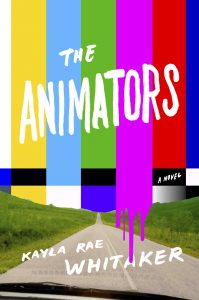by Rebecca LeBoeuf
“The Animators,” Kayla Rae Whitaker’s debut novel, has garnered praise from newspapers and magazines around the world – from The New York Times Book Review, The Washington Post and Glamour to The Sydney Morning Herald and Elle.
Published by Random House in January, “The Animators,” follows two talented artists with a friendship that spans a decade. On the cusp of success in the indie film scene, Sharon and Mel begin finding cracks in their relationship.
Whitaker is on a book tour with stops in North Carolina, Mississippi, Kentucky and even Australia.
Have you always written?
Yes. And even before I wrote, I had an all-encompassing imagination – I would envision these intricate characters and live with them, so to speak, beginning at age three or four. I probably had more conversations with imaginary people than real. I began writing every day when I was in college, even when I was preoccupied with other things. I was actually studying for the Law School Admission Test when I decided, on a whim, to apply to MFA programs.
What’s your process in developing your storyline and characters?
Stories usually occur to me voice-first: I’ll hear the character speaking. I’ll know the cadence. I’ll know a bit of where they’ve been and where they are headed. The story, and the peripheral characters, form themselves around this initial voice. “The Animators” began not with the reserved, self-contained, dry voice of its narrator, Sharon, but with her brash, ballsy collaborator, Mel Vaught, as she talked about her childhood in Florida: how enormous the rats were, how the children used to throw marshmallows to the alligators. Right away, I knew a bit of Mel’s story, but I also knew that Sharon was listening to her and was totally absorbed, not only because they are friends, but because they are both stellar storytellers, eager for detail and image. The way in which they speak to each other, listen to each other, is very specific.
What challenges do you face in your writing, and how do you overcome them?
I try to work steadily, and to not let myself get scared off by the challenges of blocks, or impatience. And a good part of that defense mechanism is sitting down and writing every day. It is a daily practice, like brushing my teeth, or working out or making breakfast. Make an action enough of a ritual, and it will become bigger than anxiety, bigger than fear – a thing on which you can depend.
What has the road to publication been like for you?
It’s been a gradual process, for which I am grateful in retrospect, because it has taught me a lot. Back when I was working on the book and I didn’t have representation, I began by submitting my works to smaller journals and magazines I liked. I highly recommend this. The playing field is also a bit more diverse than when journals were print exclusively, which is lovely. I had an office job and worked full-time while I wrote, and so the process was slow and often exhausting, but the book was a labor of love, so the toil was tender.
How do you market your work?
Marketing is not my strong suit, so I’ve learned a lot since my book came out. Random House does a tremendous amount of work on my behalf, and I try to be as available as possible for any interviews or opportunities that arise. I’ve also become a bit more active on social media (though I consider myself a novice still,) and I’ve been taking pains to travel to book fairs and festivals in order to meet readers and other writers.
What do you wish you knew when you first started writing?
I wish I knew just how much patience is a virtue when writing and editing. You can’t rush a good project. You have to put in the time and let it develop and resign yourself to the fact that you are going to write things you’ll have to edit out and trash later. It is a part of the process. Patience and faith will serve you well in that process.
Who are the authors that have inspired you most, and how have they inspired you?
Willa Cather, for her renderings of setting and for rooting her characters in place in a way that is mutually beneficial to both elements. William Faulkner, also for those down-deep characterizations – for the rendering of their subconscious lives and impulses. Stephen King, who is a master of plot momentum. Flannery O’Connor. I recall my utter surprise at reading “Good Country People” and “A Good Man is Hard to Find” as part of a class – those stories were so perverse and true, everything we’re instructed to not discuss in human nature, their humor such an affront to silence, that I was surprised to encounter them there. Those stories were a revelation.
If you could keep just three books in your library, which would you choose and why?
Nabokov’s “Lolita.” It’s the perfect book, really, in a lot of ways. Stephen King’s “It,” for reasons of both sentiment (that was a pretty formative book for me) and form (it takes great skill and attention to plot structure to make a thousand pages move with that kind of urgency). And “The Elements of Style,” which will never lead you astray.
Whitaker’s website contains a calendar list of events and highlights some of her other work.
Category:
